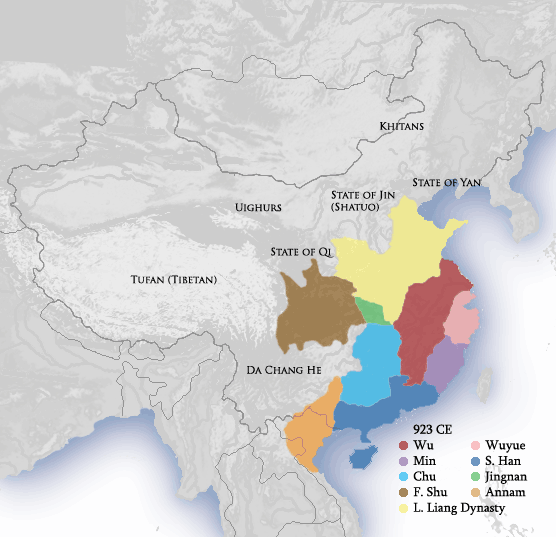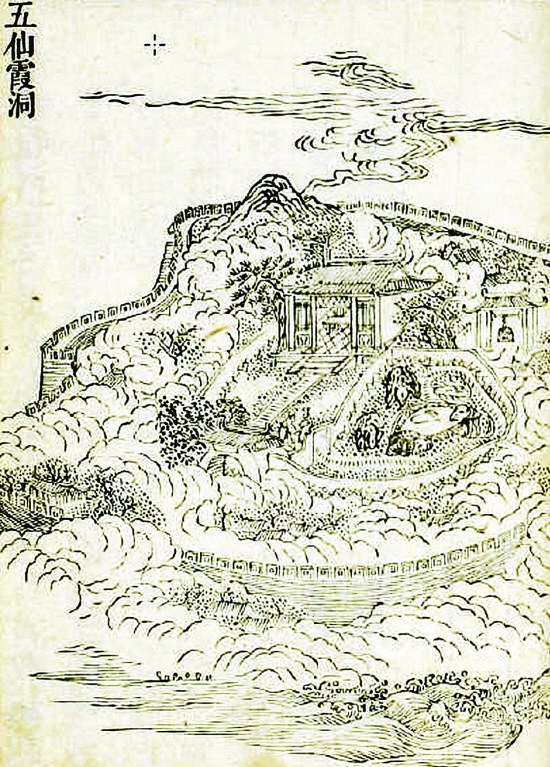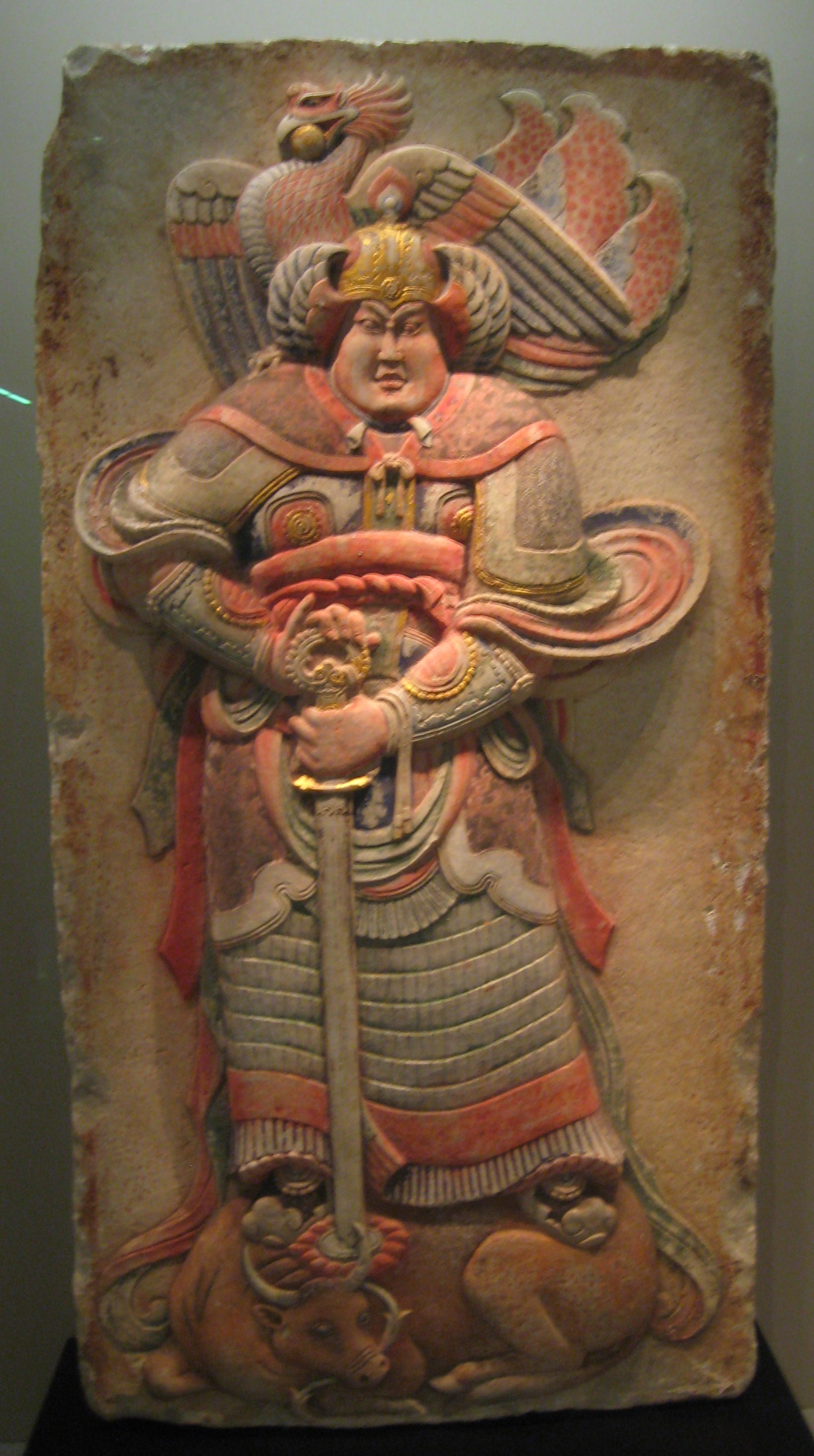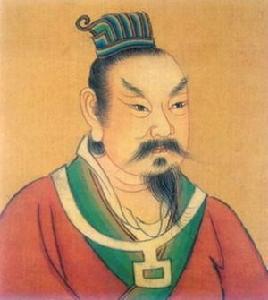|
Ngô Dynasty
The Ngô dynasty (; Chữ Nôm: 茹吳) was a dynasty that ruled Tĩnh Hải quân (Jinghai) in northern Vietnam from 939 to 968. The dynasty was founded by Ngô Quyền, who led Vietnamese forces in the Battle of Bạch Đằng River against the Chinese Southern Han dynasty in 938. Around 930, as Ngô Quyền rose to power, northern Vietnam was militarily occupied by the Southern Han and was treated as an autonomous province and vassal state of Later Tang Dynasty, referred to as Tĩnh Hải quân. Every year the Jiedushi of Tĩnh Hải quân had to pay tribute to its Chinese master in exchange for peace and political support. At the beginning of the 10th century, China was domestically plagued and weakened by civil war during what is known as the Five Dynasties and Ten Kingdoms period. The Chinese were preoccupied with these civil struggles and lost their grip on Tĩnh Hải quân periodically. Tĩnh Hải quân took advantage of this opportunity and proclaimed its indepe ... [...More Info...] [...Related Items...] OR: [Wikipedia] [Google] [Baidu] |
Ngô Quyền
Ngô Quyền ( vi-hantu, 吳權) (April 17, 898 – February 14, 944), often referred to as Tiền Ngô Vương (前吳王; "First King of Ngô"), was a warlord who later became the founding king of the Ngô dynasty of Vietnam. He reigned from 939 to 944. In 938, he defeated the Southern Han dynasty at the Battle of Bạch Đằng River north of modern Haiphong. The battle is usually remembered in Vietnamese national history as it ended 1,000 years of Chinese rule over Vietnam dating back to 111 BC under the Western Han dynasty. A central district in modern Haiphong is named after him. Early life and career Ngô Quyền was born in 898 AD in Đường Lâm (modern-day Sơn Tây District, Hanoi of northern Vietnam) during the Tang dynasty. He was the son of Ngô Mân, an influential official in Phong, Annan (today Phu Tho province). Ngô Mân's ancestor was Wu Ridai (Ngô Nhật Đại), a local tribal chief from Fuluzhou, Annan (Modern-day Ha Tinh Province). In 722, W ... [...More Info...] [...Related Items...] OR: [Wikipedia] [Google] [Baidu] |
Later Tang Dynasty
Tang, known in historiography as the Later Tang, was a short-lived imperial dynasty of China and the second of the Five Dynasties during the Five Dynasties and Ten Kingdoms period in Chinese history. The first three of the Later Tang's four emperors were ethnically Shatuo. The name Tang was used to legitimize itself as the restorer of the Tang dynasty. Although the Later Tang officially began in 923, the dynasty already existed in the years before, as a polity known in historiography as the Former Jin (907–923). At its height, Later Tang controlled most of northern China. Formation From the fall of the Tang Dynasty in 907, a rivalry had developed between the successor Later Liang, formed by Zhu Wen, and the State of Jin, formed by Li Keyong, in present-day Shanxi. The rivalry survived the death of Li Keyong, whose son Li Cunxu continued to expand Jin territories at the expense of the Later Liang. Li Keyong forged an alliance with the powerful Khitan, like the Shatuo a p ... [...More Info...] [...Related Items...] OR: [Wikipedia] [Google] [Baidu] |
Dương Đình Nghệ
Dương Đình Nghệ (Chữ Hán: 楊廷藝; pinyin: ''Yáng Tíngyì''; 874 – March 937; some sources record Dương Diên Nghệ, Chữ Hán: 楊延藝) was the jiedushi of Tĩnh Hải quân in around 931 AD. He was a skillful, talented general under Khúc Hạo, descendant of the Khúc clan who ruled Vietnam autonomously while it was technically under Chinese control for three generations. He cornered the Southern Han garrison inside Đại La and defeated their relief force, afterwards establishing himself as jiedushi. Dương Đình Nghệ was killed eventually by his general Kiều Công Tiễn who then moved up to the post of governor/administrator. This brief void left the region without rulers, until Kiều fled and Dương's son-in-law Ngô Quyền established the Ngô dynasty The Ngô dynasty (; Chữ Nôm: 茹吳) was a dynasty that ruled Tĩnh Hải quân (Jinghai) in northern Vietnam from 939 to 968. The dynasty was founded by Ngô Quyền, who led Vietname ... [...More Info...] [...Related Items...] OR: [Wikipedia] [Google] [Baidu] |
Tĩnh Hải Quân
Tĩnh Hải quân or the Jinghai Military Command ( Chinese: 靜海軍, pinyin: Jìnghǎi Jūn) (literally "Peaceful Sea Army"), also known as Annam (安南), was an administrative division of the Tang dynasty of China administered by Chinese governors, which then later became a quasi-independent regime ruled by successive local Vietnamese warlords and monarchs. It was centered around what is now northern Vietnam from 866 to 967 during the late Tang period and lasted until the late Five Dynasties and Ten Kingdoms period when Đinh Bộ Lĩnh established the Đinh dynasty. History Chinese period Jinghai Circuit (Tĩnh Hải quân) was created in 866 by Gao Pian as a Tang '' fanzhen'' ("buffer town") in the former Annan Duhufu (Protectorate General to Pacify the South) after retaking it from Nanzhao, which had invaded and captured the area in 863. The area of the Command was sometimes referred to as "Circuit" (道 dao). In 875, the Huang Chao rebellion broke out in northern China ... [...More Info...] [...Related Items...] OR: [Wikipedia] [Google] [Baidu] |
Khúc Thừa Mỹ
Khúc Thừa Mỹ (chữ Hán: 曲承美; pinyin: ''Qū Chéngměi''; governed: 918–923 or 918–930) was a self-declared jiedushi of Tĩnh Hải quân (modern northern Vietnam) during the later part of the Third Chinese domination of Vietnam, when China entered the chaotic Five Dynasties period. He succeeded his father Khúc Hạo and tried to maintain northern Vietnam's autonomy. His rule was officially recognized by the Later Liang, thus he came to conflict with Liu Yan, the ruler of Southern Han. , ''''. The Southern Han invaded in 930, capturing the capital ... [...More Info...] [...Related Items...] OR: [Wikipedia] [Google] [Baidu] |
Liu Yan (emperor)
Liu Yan (; 889 – 10 June 942), né Liu Yan (劉巖), also named Liu Zhi (劉陟) (from c. 896 to 911) and briefly as Liu Gong (劉龔), also known by his temple name as the Emperor Gaozu of Southern Han (南漢高祖), was the first emperor of the Chinese Southern Han dynasty, one of the Ten Kingdoms during the Five Dynasties and Ten Kingdoms period. Background Liu Yan was born in 889, during the reign of Emperor Zhaozong of Tang. His father Liu Zhiqian (also known as Liu Qian) was then the prefect of Feng Prefecture (封州, in modern Zhaoqing, Guangdong) and was married to a Lady Wei, the niece of Wei Zhou (韋宙), a prior military governor (''Jiedushi'') of Lingnan East Circuit (嶺南東道, headquartered in modern Guangzhou, Guangdong), which Feng Prefecture belonged to. However, he also secretly had a concubine outside the home, a Lady Duan, and it was to Lady Duan that Liu Yan was born. When Lady Wei found out, she killed Lady Duan, but could not bear to kill the ... [...More Info...] [...Related Items...] OR: [Wikipedia] [Google] [Baidu] |
Guangzhou
Guangzhou (, ; ; or ; ), also known as Canton () and alternatively romanized as Kwongchow or Kwangchow, is the capital and largest city of Guangdong province in southern China. Located on the Pearl River about north-northwest of Hong Kong and north of Macau, Guangzhou has a history of over 2,200 years and was a major terminus of the maritime Silk Road; it continues to serve as a major port and transportation hub as well as being one of China's three largest cities. For a long time, the only Chinese port accessible to most foreign traders, Guangzhou was captured by the British during the First Opium War. No longer enjoying a monopoly after the war, it lost trade to other ports such as Hong Kong and Shanghai, but continued to serve as a major transshipment port. Due to a high urban population and large volumes of port traffic, Guangzhou is classified as a Large-Port Megacity, the largest type of port-city in the world. Due to worldwide travel restrictions at the beg ... [...More Info...] [...Related Items...] OR: [Wikipedia] [Google] [Baidu] |
Later Liang (Five Dynasties)
Liang, known in historiography as the Later Liang () (1 June 907 – 19 November 923) or the Zhu Liang (), was an imperial dynasty of China and the first of the Five Dynasties during the Five Dynasties and Ten Kingdoms period. It was founded by Zhu Wen (Emperor Taizu), after he forced the last emperor of the Tang dynasty to abdicate in his favour (and then murdered him). The Later Liang would last until 923 when it was destroyed by the Later Tang dynasty. Formation Zhu Wen initially allied himself as Huang Chao's lieutenant. However, he took Huang's best troops and established his own power base as a warlord in Kaifeng. By 904, he had exerted control over both of the twin Tang Dynasty capitals of Chang'an and Luoyang. Tang emperor Zhaozong was ordered murdered by Zhu in 904 and the last Tang emperor, Ai Di ( Emperor Ai of Tang), was deposed three years later. Emperor Ai of Tang was murdered in 908, also ordered by Zhu. Meanwhile, Zhu Wen declared himself emperor of t ... [...More Info...] [...Related Items...] OR: [Wikipedia] [Google] [Baidu] |
Zhu Wen
Emperor Taizu of Later Liang (), personal name Zhu Quanzhong () (December 5, 852 – July 18, 912), né Zhu Wen (), name later changed to Zhu Huang (), nickname Zhu San (朱三, literally, "the third Zhu"), was a Chinese military general, monarch, and politician. He was a ''Jiedushi'' (military governor) and warlord who in 907 overthrew the Tang dynasty and established the Later Liang as its emperor, ushering in the era of the Five Dynasties and Ten Kingdoms. The last two Tang emperors, Emperor Zhaozong of Tang (Li Jie) and Emperor Ai of Tang (Li Zuo), who "ruled" as his puppets from 903 to 907, were both murdered by him. Zhu Wen initially served as a general under the rebel Huang Chao, but defected to the weakened Tang dynasty in 882. Taking advantage of the total chaos in the wake of Huang Chao's defeat, Zhu Wen was able to conquer parts of central China after destroying warlords such as Qin Zongquan, Shi Pu, Zhu Xuan, and Zhu Jin, although most of Shaanxi, Shanxi, and H ... [...More Info...] [...Related Items...] OR: [Wikipedia] [Google] [Baidu] |
Khúc Clan
The Khúc family or Khúc clan ( vi, Họ Khúc, Chữ nôm: 𣱆曲; ) was a succession of native leaders who ruled over Tĩnh Hải quân during the late Tang dynasty until the Five Dynasties period. The Chinese Tang dynasty took control of the region of Jiaozhi (Giao Châu; roughly corresponding to the area of the modern Red River Delta) in 621 from the preceding Sui dynasty. Later, the Tang dynasty established 12 provinces and 59 districts under the Protectorate of Annan. Effective control exercised by the Tang dynasty lasted until the 10th century, when Khúc Thừa Dụ took over as ''jiedushi'' in 905. By 906 an autonomous region in Vietnam was established under the Khúc clan in Tống Bình (near modern-day Hanoi), paving the way for total Vietnamese independence from China under Đinh Bộ Lĩnh. Preconditions The Tang took control of the northern Vietnamese region of Jiaozhi (Giao Chi; roughly corresponding to the area of the modern Red River Delta). Periodical r ... [...More Info...] [...Related Items...] OR: [Wikipedia] [Google] [Baidu] |
Huang Chao
Huang Chao (835 – July 13, 884) was a Chinese smuggler, soldier, and rebel, and is most well known for being the leader of a major rebellion that severely weakened the Tang dynasty. Huang was a salt smuggler before joining Wang Xianzhi's rebellion in the mid-870s. After splitting with Wang, his army turned south and conquered Guangzhou. In 881, his troops captured the capital Chang'an, forcing Emperor Xizong of Tang to flee. Huang proclaimed himself the Qi emperor, but was defeated by the Tang army led by the Shatuo chieftain Li Keyong in 883 and forced to desert Chang'an. Following successive defeats, including to former subordinates Zhu Wen and Shang Rang who had surrendered to Tang, Huang was killed by his nephew Lin Yan ( 林言). Background The Tang dynasty, established in 618 A.D., had already passed its golden age and entered its long decline beginning with the An Lushan Rebellion by Turkic general An Lushan. The Tang dynasty recovered its power decades after the ... [...More Info...] [...Related Items...] OR: [Wikipedia] [Google] [Baidu] |
Tang Dynasty
The Tang dynasty (, ; zh, t= ), or Tang Empire, was an imperial dynasty of China that ruled from 618 to 907 AD, with an interregnum between 690 and 705. It was preceded by the Sui dynasty and followed by the Five Dynasties and Ten Kingdoms period. Historians generally regard the Tang as a high point in Chinese civilization, and a golden age of cosmopolitan culture. Tang territory, acquired through the military campaigns of its early rulers, rivaled that of the Han dynasty. The Lǐ family () founded the dynasty, seizing power during the decline and collapse of the Sui Empire and inaugurating a period of progress and stability in the first half of the dynasty's rule. The dynasty was formally interrupted during 690–705 when Empress Wu Zetian seized the throne, proclaiming the Wu Zhou dynasty and becoming the only legitimate Chinese empress regnant. The devastating An Lushan Rebellion (755–763) shook the nation and led to the decline of central authority in the dynas ... [...More Info...] [...Related Items...] OR: [Wikipedia] [Google] [Baidu] |






